50 Greatest Star Wars Moments
Star Wars is arguably the most beloved film franchise in history. For almost half a century, the galaxy far, far away has ignited the imagination of the public, finding audiences at the box office, at home, at viewing parties, and across all media; engaging with people young, old, and in between, whether they’re from here, there, or anywhere.
It has become a staple of Western culture; a monument of our underlying beliefs, our period’s moral conundrums, our collective morality. It is mythological in nature, taking ideas from the Bible and Shakespeare, and brought to life with incredible filmmaking precision inspired by the samurai movies of Akira Kurosawa and the cowboy films of John Ford.
Some of its characters and props have become icons for all of cinema, whilst its visual effects have become universally acknowledged as being revolutionary. The central Skywalker Saga’s twists have become the most well known in all of fiction, a lot of its story beats borrowed, repurposed, and parodied in tribute to its monumental cultural and artistic impact.
The reach of this monumental series of films is unfathomable, but there is no doubting its lasting impact on every person who has engaged with it over the decades. In this Movie List from The Film Magazine, we have analysed what makes Star Wars such a juggernaut of our culture and such a beloved movie franchise. We have evaluated every story beat and every shot in an attempt to discover which moments should forever live in our cinematic consciousness. With narrative, character, direction, visual effects, score, and more, taken under consideration, these are the 50 Greatest Star Wars Moments.
Please note: we will be titling the relevant films in terms of “episodes” for sake of accessibility.
50. The Death Star Destroys Jedha City
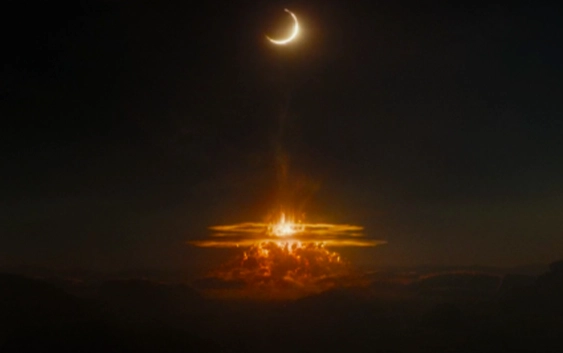
Rogue One: A Star Wars Story
In the first of the Skywalker Saga spin-offs, Rogue One, the foremost villain Orson Krennic (Ben Mendelsohn) has boarded the iconic Death Star in order to prove his weapon’s capabilities to the highest ranking official, A New Hope’s Grand Moff Tarkin (a CGI rendition of deceased original actor Peter Cushing). At the request of the Empire, he targets the well-known rebel stronghold Jedha City, and another generation is introduced to the otherworldly power of the franchise’s most famous weapon.
The CGI used to create the Death Star’s blast is nothing short of exceptional. Director Gareth Edwards shows us the debris rising from the perspective of the outer atmosphere, and the contrast that creates between the planetary materials and the cold darkness of space is a moment to remember. Composer Michael Giacchino chooses to step back in this moment, creating more emphasis on the disastrously large impact of the weapon.
For the first time in Star Wars, we’ve become acquainted with the inhabitants and geography of a planet before seeing it blasted into dust, and the filmmaking expresses the severity of our loss in a way unmatched to this point in the franchise. Bringing Peter Cushing back might have raised more than a few (important) questions regarding AI and consent to the moment’s detriment, but the severity of the blast and the foreboding it offers make for an unforgettable moment. (JW)
Recommended for you: Where to Start with the Cinema of Peter Cushing
49. The Battle of Coruscant
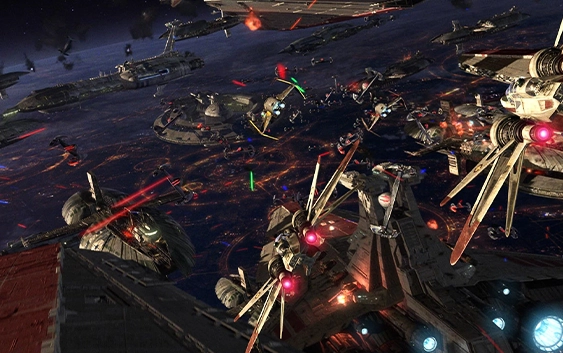
Star Wars: Episode III – Revenge of the Sith
At the end of the Clone Wars, the Separatist faction kidnap Chancellor Palpatine and lay siege to the Galactic Republic capital planet of Coruscant. As the battle above the planet rages, Jedi Obi-Wan Kenobi and Anakin Skywalker fly their starfighters through the chaos in an effort to rescue the Chancellor.
At the end of the previous Star Wars instalment, the Clone Wars began, but by the start of Revenge of the Sith the war is almost over. What George Lucas wanted to show in this opening sequence is the sheer scale and spectacle a Star Wars space battle could have now that CGI technology had finally caught up to his vision, and what better way to do this than to have our heroes’ spaceships escort us through the sub-orbital carnage in a stunning tracking shot?
Episode III arguably never gives us anything as visually arresting, and it could have constituted ocular information overload for 2005 audiences, but it’s such a cool way to open your movie and show that the ILM VFX artists were more than up to the task. (SSP)
48. Rey and Kylo Ren Touch Through Space Using the Force
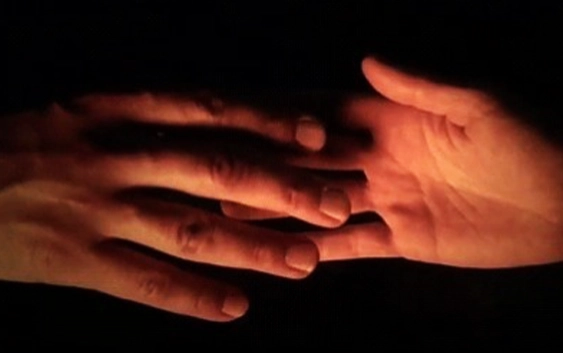
Star Wars: Episode VIII – The Last Jedi
Rey visits the mirror cave on Ahch-To in hopes of finding answers to who her parents are, to who she is. But she fails, and now she feels more alone than ever. Rey seeks comfort in Kylo Ren, another lonely soul who is just as desperate for connection and understanding as she is. After telling him that it isn’t too late, that he can still come back to the light, Rey reaches out her hand to him. In an intense, sensual moment, Kylo Ren reluctantly accepts her offer, reaching out through the force to press his finger tips against hers, the physical touch opening up theirs minds, allowing them to see into the future of what could be.
This moment is noteworthy not just because of its importance to the lore of the Force, but for the way way director Rian Johnson represents it visually. Though Rey is willing to explore the dark parts of the Force, she still stands firmly in the light – literally. In this scene, sitting in her little hut, Daisy Ridley’s face is lit by golden light from a crackling fire. We see it reflected in her eyes. In contrast, Kylo Ren is shrouded in darkness, surrounded by the sleek coldness of a First Order ship. Before taking her hand, Kylo Ren removes his glove, his armor. When he reaches out, his hand suddenly comes into contact with the light, showing just how torn he is inside. He is stuck in darkness, but he is still reaching for warmth. Daisy Ridley and Adam Driver’s performances are intense and emotional, and you can feel their longing.
Light cannot exist without darkness. To truly find balance, one must accept that we have both inside us. Rey and Kylo Ren are the embodiment of that, of both sides coming together in harmony. (MR)
47. Vice-Admiral Holdo Sacrifices Herself
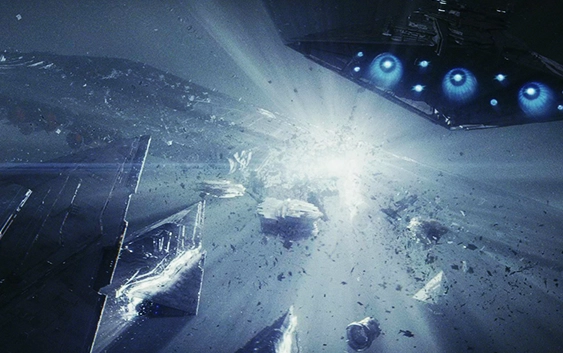
Star Wars: Episode VIII – The Last Jedi
Having fled Snoke’s Star Destoyer for days, the remaining rebel fleet is out of fuel, defenceless, and attempting to evacuate to the planet Crait below. Their only chance to not be shot down before they reach the surface is to take out the First Order’s command ship. To achieve that, Commander Holdo (Laura Dern) has a brilliant and suicidal manoeuvre to pull off: triggering a lightspeed jump into the enemy vessel.
Another sight never seen before in Star Wars is the damage that jumping to lightspeed can do in close proximity to another ship. Han Solo once warned that without the time to calculate your destination you would end up spread across space, and lo and behold he was right. Quite apart from this new character selflessly volunteering to go down with the ship for the greater cause, saving General Leia and her dwindling rebel forces in the process, the image you’re left with is an instantly iconic one for the sci-fi genre.
Holdo didn’t get much screen time, but she sure left her mark. Rian Johnson could have just gone with a big and loud explosion, but instead makes the much more striking audio and aesthetic choice to cut out the sound completely and split apart Snoke’s flagship with clean lines of white light leaking from hyperspace. (SSP)
Recommended for you: Rian Johnson Movies Ranked
46. Ben Solo’s Return
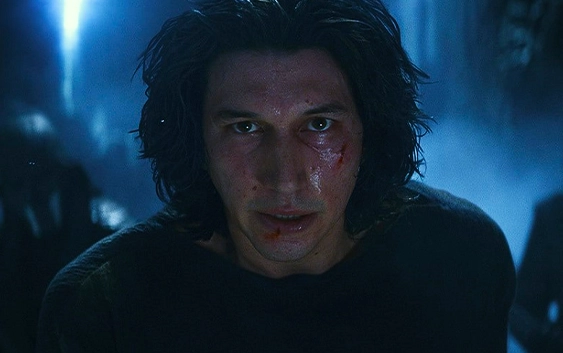
Star Wars: Episode IX – The Rise of Skywalker
In the final film of the 9-film Skywalker Saga, our new alliance is at war with an evil force controlled by the returning emperor from Episodes IV-VI, and our hero Rey is in trouble. Enter Ben Solo, no longer Kylo Ren; and he’s here to fight. Rey, under great mental duress, senses Ben, reaches behind her back and uses the force to pass Ben a lightsaber to fight with. He uses it to a deadly end for his opponents.
Rey’s indecision on whether to strike down the risen Emperor is answered as she becomes bathed in the light of her lightsaber, a cross-cut connecting her to Ben Solo. Solo himself has come from the darkest corners of the planet, literally traversing from the dark and into the light. As they connect, Ben on his knees at the hands of his nemeses, they each stare almost directly into camera as John Williams’ score fades to near silence. As they acknowledge each other, the score rises into the theme of the force, and lightning illuminates Ben’s face. As Palpatine requests “Do it!”, we know he is to be denied. Whatever good exists within Rey has won, vitally because Ben Solo’s turn has proven it to be the right path. The reveal that she has passed the lightsaber to Ben harkens back to their hands touching in The Last Jedi, when the pair held much more fractured ideas of themselves, ensuring their arcs come full circle into the closing battle between the light side and the dark.
Ben Solo’s redemption arc wasn’t received positively by everyone – some questioning the politics behind a mass murderer being given redemption – but the ties between good and evil, between unheralded awfulness and attempts at reconciliation, are vital to the core ideals that underpin Star Wars. Ben Solo eventually falls on his sword, paying the price for his actions as most villains do in this universe, but for a brief moment we are given a man who makes the most important choice any of us can make: to do the right thing. In a franchise all about making choices, there is joy to be found in one of its biggest villains choosing to be good. (JW)

